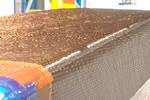Velocity Composites enters U.S. market with $100 million GKN Aerospace agreement
The composite material kits supplier expands into international markets with the development of its first U.S. manufacturing facility and a new agreement to support GKN aerostructures development.
Aerospace composite material kits supplier Velocity Composites (Burnley, U.K.) has announced its entry into the U.S. market — reported to be the largest aerospace manufacturing market in the world — with the signing of an agreement with GKN Aerospace (Redditch, U.K.) expected to be worth more than $100 million of revenue over five years.
To support the expansion into international markets, Velocity Composites also announces the development of its first site outside of the U.K., a 40,000-square-foot advanced manufacturing facility near to the GKN site in Alabama. The new facility will build and supply all the composite material kits for GKN’s aerostructures. It has been upgraded to the required cleanroom standard, and includes Velocity’s proprietary digital technology and latest manufacturing systems, covering a diverse range of high-performance composite structures across military, civil and business jet programs.
Work on the facility is at an advanced stage, and it is expected that site approvals and first article tests will be completed by the end of February 2023, followed by volume production in Q1 2023, with all programs transferred to Velocity under the agreement by Q3 2023. Velocity plans to train and employ up to 30 local staff, supported initially by existing staff from the U.K.
The collaboration with GKN — a global company known for its use of composite materials in engineered aerospace structures — uses Velocity’s advanced VRP technology and supply chain services to support GKN’s sustainability and efficiency objectives, assisting the aerospace industry’s push to achieving significant environmental and sustainability improvements in this decade.
The agreement builds on Velocity’s long-standing relationship with GKN Aerospace which started in 2015.
“This is a major milestone for Velocity as we make a permanent entry into the U.S. market and expand our long-standing relationship with GKN,” Andy Beaden, chairman of Velocity Composites, says. “During the pandemic, we worked hard to deepen our relationships with clients and further invest in our technology to prepare for the recovery.”
Beaden believes this agreement will be part of a positive long-term trend from which Velocity will benefit, as customers look to recover from the pandemic and achieve new and improved ways of working, with a key focus on sustainability, as production rates increase to pre-pandemic levels. “We expect a step change in the use of carbon fiber in aircraft structures to improve fuel efficiency and deliver greater sustainability in the move to net zero,” he continues. “We believe this will increase the adoption of Velocity’s technology and services to improve manufacturing efficiencies and inventory supply lead times.”
The agreement builds on Velocity’s long-standing relationship with GKN Aerospace which started in 2015 and includes existing contracts at three of GKN Aerospace’s U.K. sites, including Bristol, Luton and the Isle of Wight. This is the first time that Velocity has worked with GKN outside of the U.K.
Related Content
-
Partners recycle A350 composite production waste into adjustable-length rods for MFFD
Herone, Spiral RTC, Teijin Carbon Europe and Collins Aerospace Almere recycle A350 thermoplastic composite clips/cleats waste into rods for the all-thermoplastic composite Multifunctional Fuselage Demonstrator’s crown.
-
Paris Air Show 2023 highlights
The Paris Air Show, one of the largest aerospace trade shows in the world, returned for the first time since 2019 and proved that the global aviation industry industry is very much alive and kicking.
-
Cryo-compressed hydrogen, the best solution for storage and refueling stations?
Cryomotive’s CRYOGAS solution claims the highest storage density, lowest refueling cost and widest operating range without H2 losses while using one-fifth the carbon fiber required in compressed gas tanks.

















